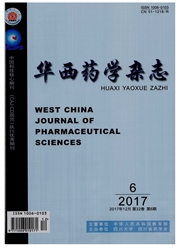

 中文摘要:
中文摘要:
目的探讨不同的消解方法对定量测定人参皂苷中5种重金属元素的影响。方法分别采用全自动湿法消解、高温高压消解和微波消解法处理样品,用电感耦合等离子体质谱法同时测定Pb、Cd、As、Cu、Hg。结果 3种消解方法对所测5种金属元素结果的精密度差异无统计学意义;全自动湿法消解所测Hg的平均回收率为65.28%,高温高压消解和微波消解法所测5种金属的加标回收率为91.38%~100.55%,RSD〈5%。结论采用全自动湿法消解法无法满足人参皂苷中5种重金属同时检测的需求,而高温高压消解和微波消解方法均能满足要求,且对样品测定结果无显著性差异。但用微波消解法更简便快速。
 英文摘要:
英文摘要:
OBJECTIVE To investigate the influence of different digestion methods for quantitative determination on 5 kinds of metal elements in ginsenoside. METHODS The automatic wet digestion, high pressure and temperature digestion and microwave digestion methods were used to conduct treatment. The contents of Pb, Cd, As, Cu and Hg were determined by ICP - MS ( Inductively coupled plasma mass spectrometry) method. RESULTS The element content accuracy results of three digestion methods after processing were not statistically different. Recovery rate of Hg by Automatic digestion method was 65.28% , but the content results by High pressure digestion and Microwave digestion method after processing were relatively stable. The recovery rates of Microwave and High pressure digestion methods were between 91.38% - 100. 55% and the relative standards deviation of precision test was less than 5%. CONCLUSION Automatic wet digestion methods can' t meet simultaneously requirement of quantitative determination and digestion requirements on 5 heavy metals content in ginsenoside, Microwave and High pressure digestions method can meet it and there is no significant difference between the determination results of ginsenoside. But considering the ,nierowave digestion method is simple and rapid.
 同期刊论文项目
同期刊论文项目
 同项目期刊论文
同项目期刊论文
 期刊信息
期刊信息
